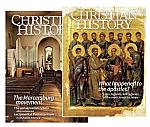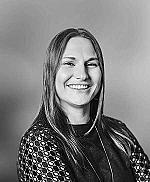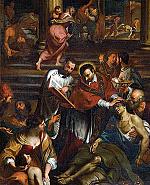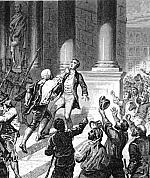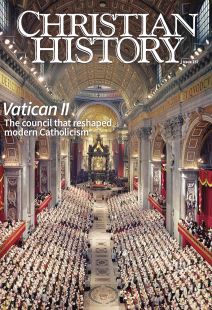Did you know? Vatican II
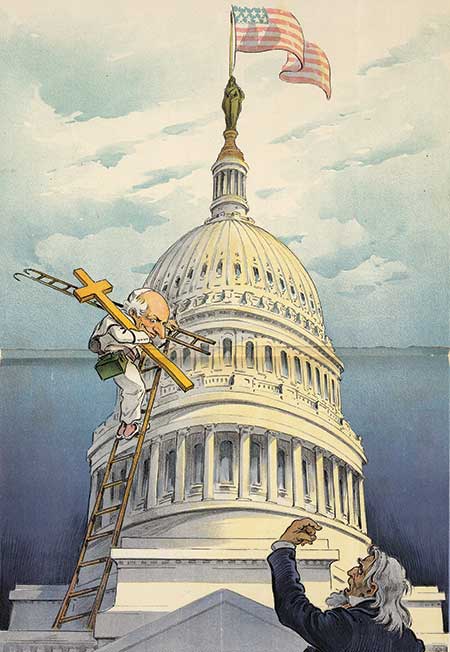
[Udo J. Keppler, The old “Americanism” good enough. 1899. Chromolithograph. from Puck, v. 45, no. 1151—Public domain, Wikimedia]
New pope, new name?
When Cardinal Robert Francis Prevost was elected pope in the spring of 2025, he took the name Pope Leo XIV. The custom of taking a new name, regularly practiced by popes at their accession since the Middle Ages, may have begun for a number of reasons. Some, such as Pope John II (c. 475–535), whose birth name was Mercurius after the Roman god Mercury, changed names to signify a rejection of pagan roots. Others changed names to recognize the dignity of the new office, much in the same manner that monarchs take new names. Today the custom continues with an eye to the future by recognizing the spirit in which past popes led the church; Leo XIV explicitly took his name to honor the memory and mission of Leo XIII, for instance.
What is…?
Here are brief definitions of some terms you’ll encounter throughout the issue.
■ Aggiornamento—an Italian word meaning “updating,” famously used as a sort of vision statement during
Vatican II
■ Collegiality—papal governance of the Catholic Church in collaboration with local church bishops and with respect to their autonomy. This is opposed to the ultramontanist (conservative) position, which assumes centralized papal authority (ultramontanism is more fully defined below.)
■ Constitution—a principal and official document produced by the Second Vatican Council. The four constitutions, which like all major Catholic documents take their titles from their first few words in Latin, are Dei Verbum, Gaudium et Spes, Lumen Gentium, and Sacrosanctum Concilium. In English they are: On Divine Revelation; On the Church in the Modern World; On the Church; and On the Sacred Liturgy.
■ Council father—a full participant in a council of the Roman Catholic Church, granted the right to both speak and vote. During Vatican II, this status was extended to “all the bishops of the world, as well as the heads of the main religious orders of men,” according to council regulations.
■ Dogma—in Catholicism, a teaching believed to be divinely revealed and infallibly defined by the church. As such, a rejection of a dogma is considered heresy.
■ Nouvelle théologie—a mid-twentieth-century intellectual movement within Catholicism (see CH #129: Modern amnesia). Called “New Theology” by its opponents because of its negative association with modernism, the movement in general sought renewal and a “return to the sources”—that is, a return to Scripture and the writings of church fathers. It also critiqued and rejected the dominance of neoscholasticism in theological interpretation, which was a revival of Thomas Aquinas’s theological methods.
■ The Roman Curia—the Catholic Church’s counterpart to the cabinet in American government: a complex array of administrative institutions that carry out the day-to-day management of the church on the international level. The departments of the Curia are typically headed by cardinals and are, since 2022, referred to as “dicasteries” (replacing the older terms “congregations” or “offices”).
■ Schemata—draft documents, prepared by a commissioned committee, that outline official church teachings during the ecumenical councils. These were subject to discussion and debate, and in the case of Vatican II, were extensively rewritten and even rejected by council fathers.
■ Synodality—a process of collaboration that brings together clergy and laity, especially women. Synodality, such as seen in the Synod of Bishops, seeks to involve the whole people of God in discerning the life and mission of the church.
■ Ultramontanism—an emphasis on papal power above other ecclesial authorities—for example, the pope’s unilateral power to appoint bishops and override local decisions. This was a model that dominated Catholic hierarchal structure between Vatican I and Vatican II. (Ultramontanism literally means “beyond the mountains,” referring to Italy, across the Alps from France.)
Heresy detectors
The branch of the Curia concerned with church discipline and the clarification of Catholic doctrine is called the Dicastery of the Doctrine of the Faith (but it has gone by several other names historically). Originally founded by Paul IV as the “Roman and Universal Inquisition” in 1542, it had the authority to issue doctrinal statements that clarified disputed points of church teaching and to investigate heresy and other religious offenses, including abusive behavior by priests. Under Joseph Ratzinger (later Benedict XVI), it became more zealous in attempting to silence theologians deemed unorthodox, including Hans Küng (1928–2021) who had once worked with Ratzinger as an expert at Vatican II (see pp. 45–49).
Council spy
Much of what the world knew of the inner workings of Vatican II was thanks to the priest-turned-journalist Francis X. Murphy (1914–2002). Murphy was a Redemptorist (see “Viva! Viva! Gesu!” in CH #151) and attended the council as a theological advisor, where he grew incensed by the Curia’s attempts to control the council and block reform. Under the pseudonym Xavier Rynne, Murphy published a series of articles called “Letters from Vatican City” in The New Yorker. These articles, sensational and often unflattering to his opponents, grabbed worldwide attention and shaped popular opinion of the council. Vatican officials suspected Murphy of being Xavier Rynne and tried to prove it; Murphy only admitted his authorship in 1998, four years before he died at age 87. CH
By the editors
[Christian History originally published this article in Christian History Issue #157 in 2025]
Next articles
Letters to the editor, Vatican II issue
Readers respond to Christian History
our readers and editorsPiety and power
Politics, reforms, and lay movements shaped Catholicism’s modern era
Edwin Woodruff TaitSupport us
Christian History Institute (CHI) is a non-profit Pennsylvania corporation founded in 1982. Your donations support the continuation of this ministry
Donate



